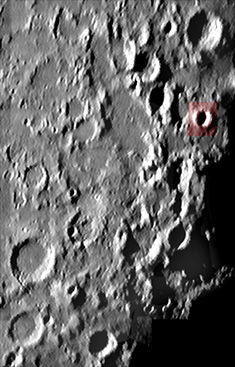Al-Farghânî, known in the West as Alfraganus , was one of the most famous astronomers of the 9th century. His book, Elements of Astronomy, written in 833 CE remained as the most popular text book on astronomy until the 15th century, both in the West and in the East.
  |
| Figure 1. An image of Alfraganus’ Crater on the moon. |
![]()
![]()
Al-Farghânî, known as Alfraganus in the West, was one of the famous astronomers of the 9th century. His book, Elements of Astronomy, written about 833 was the most popular book on astronomy until the 15th century in both the West and the East and was used as a textbook in astronomy. The book was translated into Latin in the 12th century and exerted a great influence upon European astronomy before Regiomontanus. Although Alfraganus’ Elements of Astronomy was a summary of Ptolemy’s Almagest, Ptolemy’s views are questioned, because there are some differences between the two works. This paper firstly shows those differences and secondly demonstrates why Elements of Astronomy had such an immense and lengthy influence on Western as well as Eastern astronomy.
The Elements of Astronomy
This book was written by Alfraganus about 833 (certainly before 857 CE). It was about celestial motions, including a complete study on the science of the stars and consisted of thirty parts. The Introduction of the book reads as follows; “This book named as The Elements of Astronomy is one of the books prepared for this science and the most compact of that. It is classified by Ahmed b. Muhammad b. Kasîr al-Fargânî al-Hâsib”. The book consists of thirty chapters.
Alfraganus did not repeat some mistakes which appeared in the Almagest. For example, looking at the distances of planets from the earth given by Ptolemy, there is empty space between Venus and the Sun. This is contrary to Aristotelian cosmology. On the other hand, Alfraganus does not make such a mistake. There is no empty space in The Elements of Astronomy.
  |
| Figure 2. The cover page of the Latin translation of Alfraganus’ book of astronomy. |
The Elements of Astronomy was one of the most popular books on astronomy in both the East and West, and was used as a textbook on astronomy until the 15th century. Alfraganus was perhaps the first Muslim astronomer to write on astronomy. By summarizing and simplifying the Almagest Alfraganus had a major influence on Islamic astronomy. Islamic astronomers accepted his ideas, especially the value of precession which was different from Ptolemy’s value and the distances and diameters of planets in his work. Ikhwân al-Safâ and al-Battânî made use of Alfraganus’ book.
The Elements of Astronomy greatly influenced Western Astronomy and it was translated several times. The first translation of the book into Latin was made by John of Seville in 1137 under the title of Differentia Scientie Astrorum.
The Elements of Astronomy exerted a great deal of influence upon European astronomy before Regiomontanus. There are many references to it in medieval writers and there is no doubt that it was responsible for the spread of Ptolemaic astronomy, at least until this role was taken over by Sacrobosco’s Sphaera. Even then, The Elements of Astronomy continued to be used until the 15th century.
Alfraganus influenced the Italian poet Dante Alighieri (1261-1321) whose main source of astronomical knowledge he was. Dante studied it in the Latin translation. Dante’s cosmology in the Il convivio and the Divina Commedia was adopted from Alfraganus’ Elements of Astronomy. Dante quoted Alfraganus or his book only twice in the Convivio. Dante’s son Jacopo di Dante Alighieri also used Alfraganus.
Alfraganus also greatly influenced Columbus who used Alfraganus’ value of the measurement of the earth. Columbus’ theoretical basis for the assumption that the western ocean was not vast was borne out by his practical experience as a sailor. According to a note in his own hand in his copy of “Imago Mundi,” Columbus navigated by using the erroneous calculations of Alfraganus. Using Alfraganus’ value of 56 2/3 land miles per equatorial degree, Columbus assumed that he had only to sail approximately 2,500 miles westward from the Canary Islands in order to reach the Orient. Columbus asserted that his voyages had confirmed the cosmography of “Imago Mundi” and the calculations of Alfraganus. Columbus himself thought that he was navigating according to Alfraganus’ value and he wrote: “Observe that in sailing often from Lisbon southward to Guinea, I carefully measured the course … and in agreement with Alfragan I found that each degree answered to 56 2/3 miles. So that we may rely upon this measure.”
4.5 / 5. Votes 154
No votes so far! Be the first to rate this post.
Muslim Heritage:
Send us your e-mail address to be informed about our work.
This Website MuslimHeritage.com is owned by FSTC Ltd and managed by the Foundation for Science, Technology and Civilisation, UK (FSTCUK), a British charity number 1158509.
© Copyright FSTC Ltd 2002-2020. All Rights Reserved.
